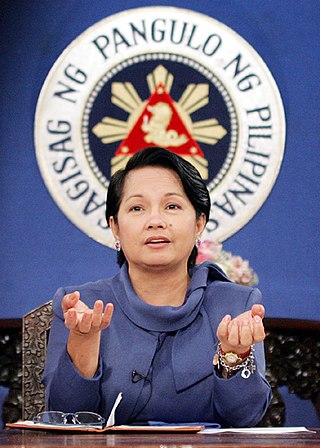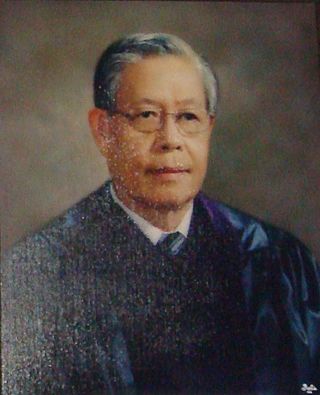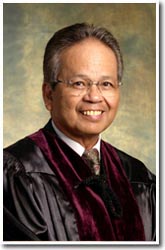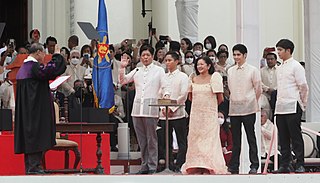
Maria Gloria Macaraeg Macapagal-Arroyo, often referred to by her initials PGMA and GMA, is a Filipino academic and politician who previously served as the 14th President of the Philippines from 2001 to 2010. She is the longest serving president of the Philippines since Ferdinand Marcos. Before her accession to the presidency, she served as the 10th Vice President of the Philippines from 1998 to 2001 under President Joseph Ejercito Estrada, making her the country's first female vice president, despite having run on an opposing ticket. She was also a Senator from 1992 to 1998. After her presidency, she was elected as the Representative of Pampanga's 2nd district in 2010 and later became the Speaker of the House of Representatives on 2018 to 2019. She was also serving in the congress as a Deputy Speaker from 2016 to 2017 and from 2022 until 2023. She is one of the only 2 Filipinos to hold at least three of the four highest offices in the country: vice president, president, and house speaker, alongside former President Sergio Osmeña.

The Second EDSA Revolution, also known as the Second People Power Revolution, EDSA 2001, or EDSA II, was a political protest from January 17–20, 2001 which peacefully overthrew the government of Joseph Estrada, the thirteenth president of the Philippines. Following allegations of corruption against Estrada and his subsequent investigation by Congress, impeachment proceedings against the president were opened on January 16. The decision by several senators not to examine a letter which would purportedly prove Estrada's guilt sparked large protests at the EDSA Shrine in Metro Manila, and calls for Estrada's resignation intensified in the following days, with the Armed Forces withdrawing their support for the president on January 19. On January 20 Estrada resigned and fled Malacañang Palace with his family. He was succeeded by Vice President Gloria Macapagal Arroyo, who had been sworn into the presidency by Chief Justice Hilario Davide Jr. several hours earlier.

Hilario Gelbolingo Davide Jr. is a Filipino lawyer, professor, diplomat, constitutionalist and former politician, who served as the 20th Chief Justice of the Supreme Court of the Philippines and Permanent Representative of the Permanent Mission of the Republic of the Philippines to the United Nations. As constitutionalist, Davide led the creation of the Legislative branch, and also wrote the most resolutions and the bulk of the 1987 Constitution of the Philippines, becoming its father and primary author.

The Commission on Elections, abbreviated as COMELEC, is one of the three constitutional commissions of the Philippines. Its principal role is to enforce all laws and regulations relative to the conduct of elections in the Philippines.

The vice president of the Philippines is the second-highest official in the executive branch of the Philippine government and is the first in the presidential line of succession. The vice president is directly elected by the citizens of the Philippines and is one of only two nationally elected executive officials, the other being the president.

Artemio Villaseñor Panganiban Jr. is a Filipino jurist. He served as the 21st Supreme Court Chief Justice of the Philippines from 2005 to 2007.
Impeachment in the Philippines is an expressed power of the Congress of the Philippines to formally charge a serving government official with an impeachable offense. After being impeached by the House of Representatives, the official is then tried in the Senate. If convicted, the official is either removed from office or censured.

This article covers the history of the current Philippine republican state following the 1986 People Power Revolution, known as the Fifth Philippine Republic.
The trial of Philippine president Joseph Estrada took place between 2001 and 2007 at the Sandiganbayan. Estrada, popularly called Erap, was resigned from office in 2001 during a popular uprising in Metro Manila after an aborted impeachment trial in which he was charged with plunder and perjury. Soon after his ouster, the same charges were filed against him at the Sandiganbayan.
The 2004 presidential campaign of Fernando Poe Jr. was formally launched on November 27, 2003, upon announcing his candidacy at the Manila Hotel in the City of Manila. Poe was the Koalisyon ng Nagkakaisang Pilipino (KNP)'s nominee for President of the Philippines in the 2004 election. He chose Loren Legarda, the sitting Majority Floor Leader of the Philippine Senate, as his vice presidential running mate on January 1, 2004. A public figure in his movie career and known for his charitable but unpublicized endeavours, he targeted his candidacy at the same poor whom he championed in his films. Poe accepted the nomination in December 2003 and was to be the standard opposition bearer for the Philippines' 2004 presidential election. Some accounts portray him as a reluctant candidate who was only prevailed upon to accept the nomination by his best friend, deposed former President Joseph Estrada. But other accounts say he was convinced to cast his bid for the presidency because of the overwhelming crowd that gathered for the first rally of the FPJ for President Movement at the Cuneta Astrodome in Pasay.

The inauguration of the president of the Republic of the Philippines is a ceremony marking the commencement of the six-year term of a president of the Philippines, who is both head of state and head of government. The inauguration is performed on June 30, as mandated by the 1987 Constitution. Under the older 1935 Constitution, the date was December 30, which is also Rizal Day; the last inauguration held on the older date was Ferdinand Marcos' second one on December 30, 1969. The most recent public presidential inauguration ceremony was that of President Bongbong Marcos, who began his six-year term in office on Thursday, June 30, 2022.

The presidency of Gloria Macapagal Arroyo, also known as the Arroyo administration, spanned nine years from January 20, 2001, to June 30, 2010. She served the remainder of her predecessor Joseph Estrada's term after he was deposed, and she was elected to a full second term in 2004 which ended in 2010. Arroyo is the daughter of 9th president Diosdado Macapagal.

The presidency of Joseph Ejercito Estrada, also known as the Estrada administration, spanned 31 months from June 30, 1998, to January 20, 2001. Estrada was elected president of the Philippines in the May 11, 1998 national elections, receiving almost 11 million votes.

The presidential transition of Benigno Aquino III began when he won the 2010 Philippine presidential election. On June 9, 2010, at the Batasang Pambansa Complex, in Quezon City, the Congress of the Philippines proclaimed Aquino as the president-elect of the Philippines, following the 2010 election with 15,208,678 votes, while Jejomar Binay, the former mayor of Makati, was proclaimed as the vice president-elect of the Philippines with 14,645,574 votes, defeating runner-up for the vice presidency Mar Roxas, the standard-bearer of the Liberal Party for vice president.

The inauguration of Benigno S. Aquino III as the fifteenth president of the Philippines took place on Wednesday, June 30, 2010, at the Quirino Grandstand in Manila. The oath of office was administered by Associate Justice of the Supreme Court of the Philippines Conchita Carpio-Morales.
The inauguration of Joseph Estrada as the thirteenth president of the Philippines took place on Tuesday, June 30, 1998, at the Barasoain Church in Malolos, Bulacan. The oath of office was administered by Chief Justice of the Supreme Court of the Philippines Andres Narvasa. Afterwards, Estrada delivered his inaugural speech at the Quirino Grandstand in Manila. The inauguration was held during the Centennial of Philippine Independence. The Inauguration was organized jointly by the Presidential Transition Cooperation Team of outgoing President Fidel V. Ramos and the Transition Team of incoming President Estrada. This was the last presidential oath administered by Narvasa.

The second inauguration of Gloria Macapagal Arroyo as the fourteenth president of the Philippines took place on Wednesday, June 30, 2004 at the Cebu Provincial Capitol in Cebu City. The inauguration marked the commencement of the second term of Gloria Macapagal Arroyo as president and the only six-year term of Noli de Castro as Vice President. The oath of office was administered by Chief Justice of the Supreme Court of the Philippines Hilario Davide, Jr. Before that, Arroyo delivered her inaugural speech at the Quirino Grandstand in Manila.
The Philippine Truth Commission was created to find out the truth about reports of large scale graft and corruption in the previous government; to put a closure to them by the filing of the appropriate cases against those who were involved. Furthermore, to deter others from committing such crimes and to restore the people's faith and confidence in the government and in their public servants. On July 30, 2010, President Benigno Aquino III set up the Philippine Truth Commission to find out the truth about reports of large scale graft and corruption in the previous government and to put a closure to them by the filing of the appropriate cases against those who were involved. Furthermore, to prevent others from committing such crimes and to restore the people's faith and confidence in the government and in their public servants.
The Philippine presidential line of succession defines who becomes or acts as president upon the incapacity, death, resignation, or removal from office of a sitting president or a president-elect.

The inauguration of Bongbong Marcos as the 17th president of the Philippines took place around noon (PHT) on Thursday, June 30, 2022, at the National Museum of Fine Arts. The chief justice of the Supreme Court Alexander Gesmundo administered the oath of office, a first in 18 years, since the previous two presidential oaths were administered by an associate justice.














